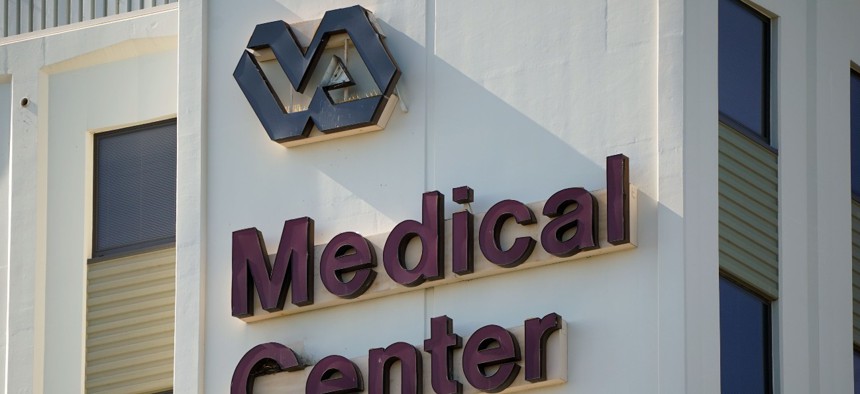
The Tibor Rubin Veteran Affairs Medical Center in Long Beach, Calif. VA has a high workload due to veterans seeking new benefits and health care services available to them under the PACT Act. Scott Varley/MediaNews Group/Torrance Daily Breeze via Getty Images
Mandatory Overtime at VA Is Not Going Away Any Time Soon, Though Officials Acknowledge It's a Problem
It is all hands on deck as VA looks to handle a surge of new work.
Though the Veterans Affairs Department recognizes that requiring its employees to take overtime is not sustainable in the long term, it will continue to use the strategy for the foreseeable future to keep pace with the influx of veterans seeking new benefits and health care services.
VA officials told lawmakers on Tuesday the department is looking to significantly boost its permanent workforce to address the increased workload, but—despite some success—the efforts have not yet proven sufficient. The surge in claims followed the Honoring Our Promise to Address Comprehensive Toxics (PACT) Act, which President Biden signed into law earlier this year to newly presume, for the purposes of eligibility for care and benefits from the VA, that 23 respiratory illnesses contracted by veterans are related to burn pits used in the military.
The Veterans Benefits Administration has increased its workforce by 15% over the last 18 months to a total of 28,000, Joshua Jacobs, the component’s director, told members of the House Veterans' Affairs Committee. VBA hired 2,000 new employees just before PACT Act implementation began and has continued an "aggressive hiring campaign" ever since, including through hiring fairs across the country. The increased staff and extra work hours have paid dividends: after setting a record for claims processed in fiscal 2022, VBA is outpacing that rate so far this year by 14%. It is now regularly topping more than 8,000 claims completed in a single day, doing so on 39 occasions this fiscal year compared to just six times ever before 2023.
Still, the caseload is overwhelming. VA has conducted 3.3 million toxic exposure screenings since the PACT Act’s passage, with 43% of veterans reporting a concern. More than 500,000 veterans have submitted a PACT Act-related claim.
To keep up with demand, VBA has required 20 hours of mandatory overtime per two-week pay period.
“My goal is to move away from mandatory overtime,” Jacobs said. “I don't think it's a sustainable practice, but we also can't yet move away from it completely because of the total workload.”
He noted VBA will give a reprieve to employees over the summer, as it did during the holiday period last winter. He added the hiring and new technology that will automate some processes to make employees more efficient will eventually reduce the need for the added hours. For now, however, Jacobs said the priority is ensuring that "veterans aren't waiting lengthy periods of time."
Patricia Hastings, VA's chief consultant for health outcomes and military exposures, said the new presumptive illnesses were really buckets that included dozens of subcategories, bringing the real total closer to 300 new possible qualifiers. So far, VA is approving about 80% of claims. The burden of the workload is forcing VA to learn and adapt on the fly.
“It took years to create the PACT Act and it took months to implement it, and that can be a little overwhelming for” the workforce, said Rep. Mike Luttrell, R-Texas, who chairs the subcommittee that held Tuesday's hearing. “We need to give them exactly what they need to be successful.”
Jacobs highlighted that VBA has already adapted to “refine and improve our processes and outcomes” based on lessons learned. It has created new training for toxic exposure cases, issued memoranda to ensure uniform application of the law, and identified areas for automation and improved technology.
The Veterans Health Administration is also significantly boosting its workforce as more veterans become eligible for care. VHA added nearly 10,000 employees to its rolls in the first five months of fiscal 2023, marking 2.5% growth. Its total hires in the first part of the fiscal year led to an increase of 28% compared to the same period in 2022. Its hiring levels in December and January set all-time records and it is expecting to exceed its hiring goal for the year.
VA still has 76,000 vacancies across the department, according to its own data, though it has typically attributed the bulk of that total to regular turnover.







